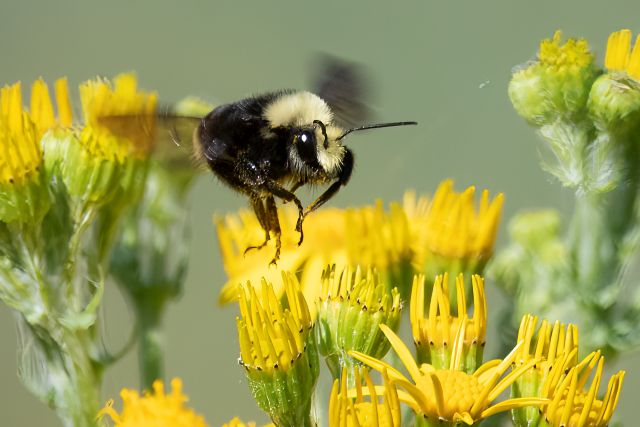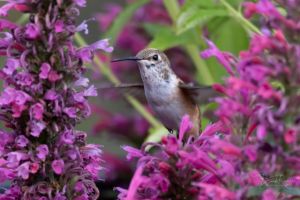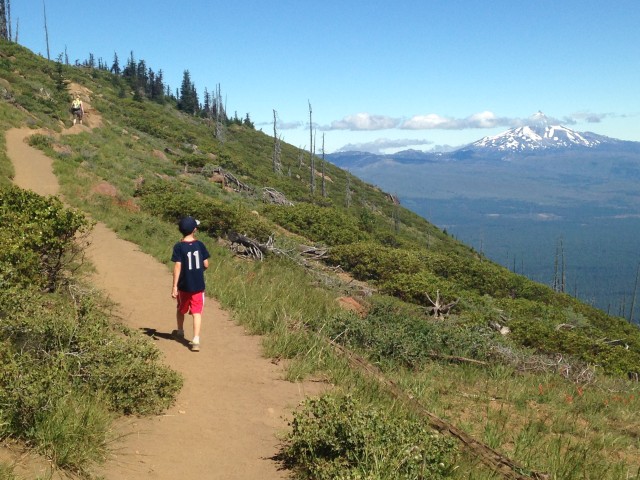Guest column: Infuse your garden with native plants
Published 4:19 pm Thursday, June 5, 2025

- A bee in flight over native goldenrod. Along with penstemon and yarrow, goldenrod can provide great color, nectar and structure throughout the growing season. (Barbara Rumer)
Humans and nature go way back. Some might say we’re inseparable. Perhaps that’s why so many of us find that our yards and gardens provide us with a sense of refuge when we tire of the built environment. A garden connects us with the earth, and brings natural beauty and flourishing biodiversity to our doorstep.
A garden reminds us that nature doesn’t need to be something that’s “out there.” It can be right here, buzzing and twittering and blooming among us in our cities.
That’s soothing for us and a real good thing for nature, too, because nature needs every inch it can get these days. Between the effects of deforestation, monocropping, desertification, drought, climate change and more, biodiversity is declining at an unprecedented rate. Over one million species are currently at risk of extinction, according to the United Nations.
Faced with these worldwide environmental challenges, it may be hard to imagine how “regular” people can help stave off species extinction. But there are ways, within our everyday lives, that we can help counteract the negative trends and planting a garden filled with native plants is one of them.
While it’s not a panacea for our global ecological problems, incorporating native plants into our gardens does make a difference locally, as a strategy to both conserve water and support local wildlife. And it’s something that nearly anyone can participate in — beginners with “black thumbs,” renters with a small balcony, or homeowners with small or large yards.
First steps
No one will say that growing a garden in Central Oregon is easy. Our arid, High Desert climate, with extreme heat and cold, a short growing season and often rocky, sandy, nutrient-poor soils, combine to make it a particularly challenging landscape — but that is for plants that aren’t from here. This is a key reason to plant natives. By choosing plants that evolved over millennia to thrive in this landscape, we spare ourselves from wasteful water use, labor-intensive gardens and lawns, and costly, wishful (and ultimately disappointing) planting.
Getting started for renters
No yard? No problem. Many plants can be grown in pots on a sunny deck or balcony. Go with the largest pots you can fit in your space, make sure they have good drainage, and choose a selection of plants that will give you a variety of bloom windows and flower types. Plants with tubular flowers will attract hummingbirds and bumblebees, while flat or daisy-like blooms will draw in butterflies, hoverflies and native solitary bees. Agastache, penstemons, bleeding heart, fleabanes, milkweeds and asters are all good bets.

A hummingbird peeks through a cluster of agastache. (Barbara Rumer)
Avoid non-native plants that can disrupt local ecosystems and avoid plants treated with neonicotinoids and other chemical pesticides and herbicides that harm wildlife.
If pots or windowsill gardens aren’t an option for you, consider reaching out to your landlord or management company to see if they’d shift to low-maintenance native landscaping.
Getting started for property owners
Don’t rush to the plant store without a plan. Watch your space first. How much sun does it get? At what times of day, and for how long? Base your planting plans on the reality of your sun situation and your ability to get water to plants when they need it. Remember that even drought-tolerant native plants need regular watering to get established, so give them big, daily gulps for the first few weeks.
When you are ready to buy, support the local nurseries that carry a wide selection of native plants and can you give expert advice.
If you have enough space, shrubs like chokecherry, willow, rabbitbrush, vine maple and serviceberry will support many different types of pollinators while beautifully filling your space. For medium-sized flowering plants, consider penstemon, goldenrod and yarrow. These provide great color, nectar and structure throughout the growing season — and will thrive in Central Oregon’s unique climate. Mountain beebalm, another wonderful option, will draw bees and butterflies alike with its fragrant, late-summer blooms. For your borders and edges, think about low-growing plants like sulphur buckwheat, fernleaf biscuitroot and narrowleaf mule’s ears. These are all beautiful, hardy natives that are well-adapted to our region’s dry summers and cold winters.
Along with including a variety of flowering plants to support a diverse pollinator population, two more pro-wildlife moves are to provide water sources like shallow dishes with rocks and to leave bare ground or small logs for nesting insects. If you have fencing, make sure it’s wildlife-friendly.
Whatever question you may have while getting started, someone else has, too, so just ask. The Native Plant Society of Oregon-High Desert Chapter and Pollinator Pathway Bend are two local groups with loads of firsthand gardening know-how and there are many great gardening resources available online and in local libraries.
More coverage: Native hummingbird garden takes root in Bend
Planting for a sustainable future
Environmental stewardship applies at every scale and across a variety of actions.
City governments, nonprofits organizations, and urban residents can all work together to support nature at the local level. Many urban challenges, such as urban heat islands and stormwater pollution can be mitigated with green infrastructure such as tree canopy, rain gardens and bioswales. Green infrastructure is more resilient in extreme weather events and is essential to support public health — especially for the young and elderly, those with preexisting health conditions, outdoor workers and low-income residents. No less important: keeping nature nearby in our cities also provides significant mental health benefits.

Honey bee enjoying showy milkweed at Franklin Corner Pollinator Garden. (Barbara Rumer)
Keeping nature nearby is a core element of Central Oregon LandWatch’s Cities and Towns program. LandWatch was involved in the formation of the City of Bend’s first tree code, and will be watching to see that code is upheld and that it is effective. We also serve on the City’s water advisory committee and participate in many other initiatives geared toward making our region’s cities more biophilic.
Our urban neighborhoods can support wildlife if we provide the right environment, and native gardens definitely help. Migrating birds might stop for a snack and a nap in your neighbor’s serviceberry. A mule deer making his or her way through town en route to the forest and sagebrush beyond city boundaries will depend on finding food like rabbitbrush, antelope bitterbrush and big sagebrush, as well as shade in your neighborhood. Pollinators may avail of your garden’s milkweed, penstemon and water feature on their journey to a nearby farm.
Hopefully you’re convinced that thinking globally and acting locally can be as simple as planting a native garden. It’s a surefire way to cultivate joy, all while knowing you’re conserving precious water and providing essential food and shelter for the insects and animals that also call the city home.
Replacing grass with natives
If you have a yard, chances are good that you have grass and that you water it regularly. Collectively. our lawns are the largest irrigated crop in the United States.
Many property owners, in a well-intentioned effort to reduce their water consumption, have transitioned their water- and labor-intensive lawns to rockscapes. That approach does save water, and it’s true that rocks don’t need to be mowed, but rocks don’t sequester carbon or support pollinators. Replacing some parts of your lawn with native plants will do better on both those fronts and can still be fairly low maintenance.
The City of Bend has Turf Replacement Rebate and WaterWise Communities programs designed to support property owners in the transition from water-intensive turf landscapes to more water-efficient, diverse, and native landscapes. Last year, these programs replaced 43,680 square feet of cool season lawns with over 4,000 low water use, climate-appropriate, and native plants — with a collective water savings of 829,920 gallons in just the first year.
Kristin Reidelberger is cities and towns associate program manager at Central Oregon LandWatch.







